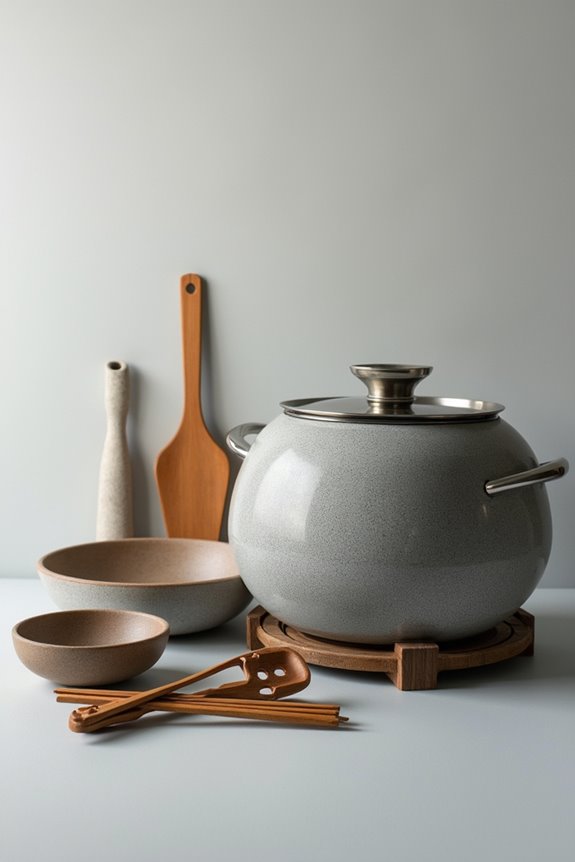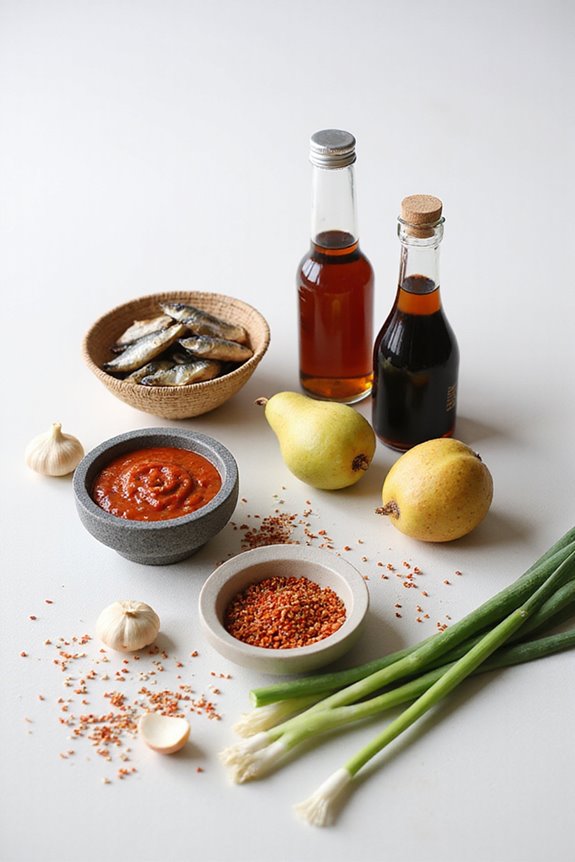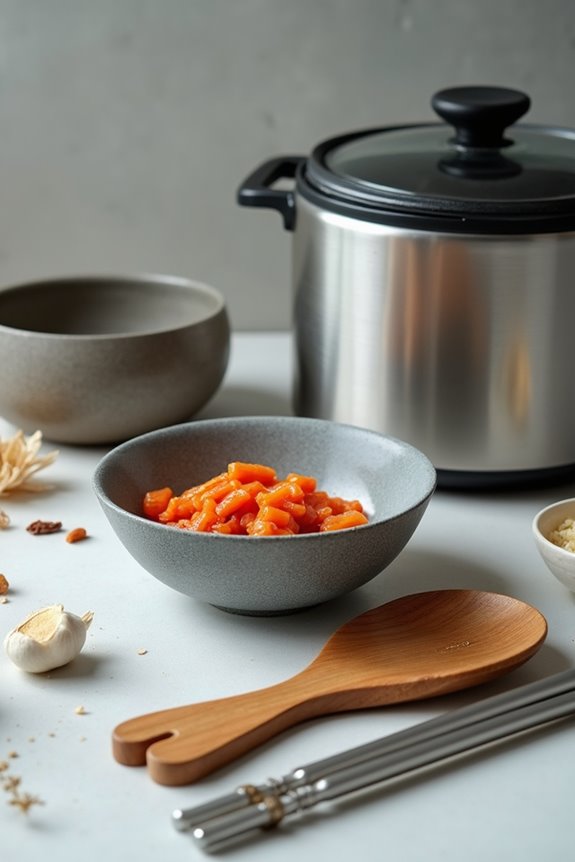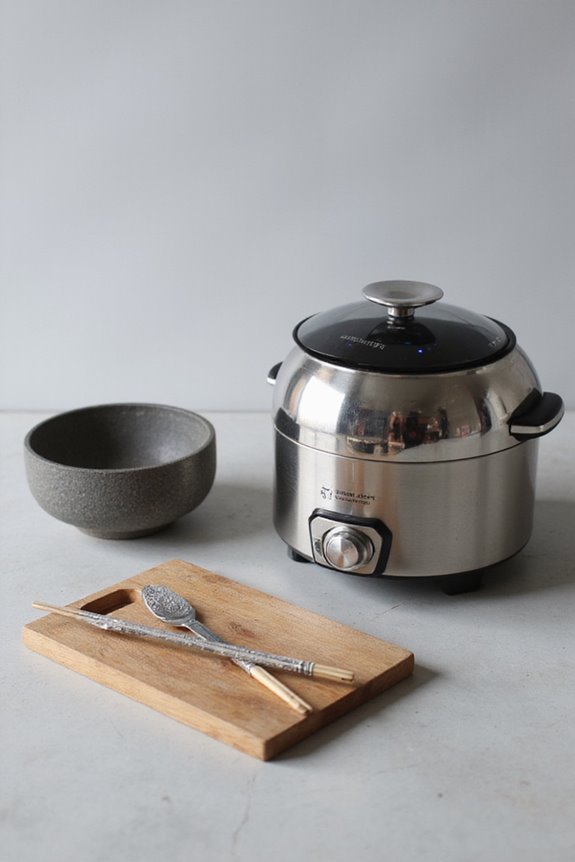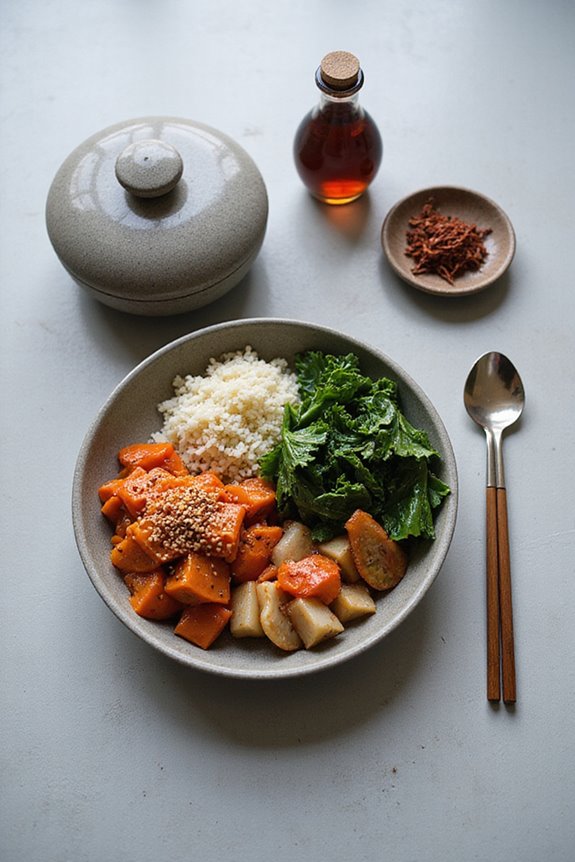To effectively prepare authentic Korean dishes, we need essential cooking vessels like ttukbaegi for stews and dolsot for bibimbap, providing unique flavors and textures. Key kitchen tools include various chopsticks, cooking scissors, and sturdy spatulas for efficient food handling. Appliances such as food processors and automatic rice cookers simplify meal prep and guarantee consistent results. For BBQ, specialized grills and accessories are critical. Finally, specialty refrigeration helps maintain ingredient freshness. Further details on these tools can enhance your cooking experience.
Key Takeaways
- Essential cooking vessels like ttukbaegi for stews and dolsot for bibimbap enhance authentic Korean flavors and communal dining.
- Use various types of chopsticks and Sujeo (Korean spoons) for effective rice and soup consumption.
- Equip your kitchen with a food processor and handheld blender for efficient chopping and blending of ingredients.
- Invest in automatic rice cookers for easy rice preparation and larger models for family gatherings.
- Utilize specialty refrigeration units for precise temperature control of kimchi and efficient storage of marinated ingredients.
Essential Cooking Vessels for Korean Dishes
When we think about the essential cooking vessels for Korean dishes, several key items come to mind that play a significant role in the preparation of traditional meals. The Ttukbaegi, or earthenware pot, is indispensable for cooking rich stews like kimchi jjigae and sundubu jjigae, offering excellent heat retention that keeps food hot during serving, enhancing flavor. Its versatility means it can also double as servingware. Similarly, the Dolsot, or stone bowl, excels in preparing bibimbap, providing not only a crispy rice crust but also retaining heat effectively. Both vessels contribute unique qualities to Korean cuisine, making them vital for achieving authentic taste and presentation while allowing for communal dining experiences that reflect our culinary traditions. The heat retention features of these bowls ensure that meals stay warm and flavorful until the very last bite.
Key Kitchen Tools and Utensils
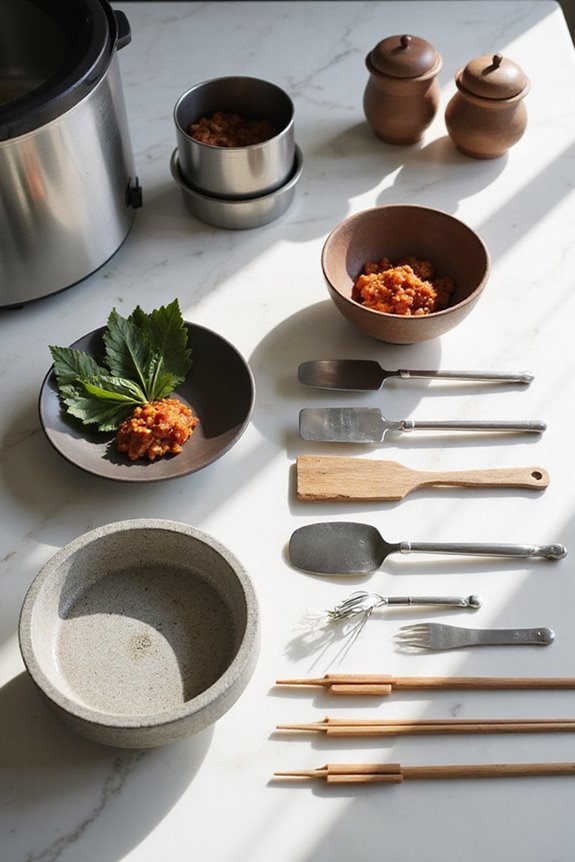
The preparation of Korean dishes extends beyond cooking vessels; it also heavily relies on the right kitchen tools and utensils. Key items include various chopstick types, with longer cooking chopsticks that facilitate safe handling during cooking. These chopsticks, typically bamboo, are great for turning dumplings or cooking jeon. For dining, metal chopsticks paired with Korean spoons, known as Sujeo, are essential for enjoying rice and soup dishes. Additionally, cooking scissors are invaluable for cutting ingredients like kimchi or meat directly on the pan or table. A combination of sturdy spatulas—like stainless steel and wooden—is vital for flipping delicate items, ensuring the integrity of dishes like seafood pancakes while maneuvering through various cooking techniques effectively. Furthermore, investing in high-quality stainless Korean cooking scissors can significantly enhance your meal preparation efficiency.
Food Preparation Appliances
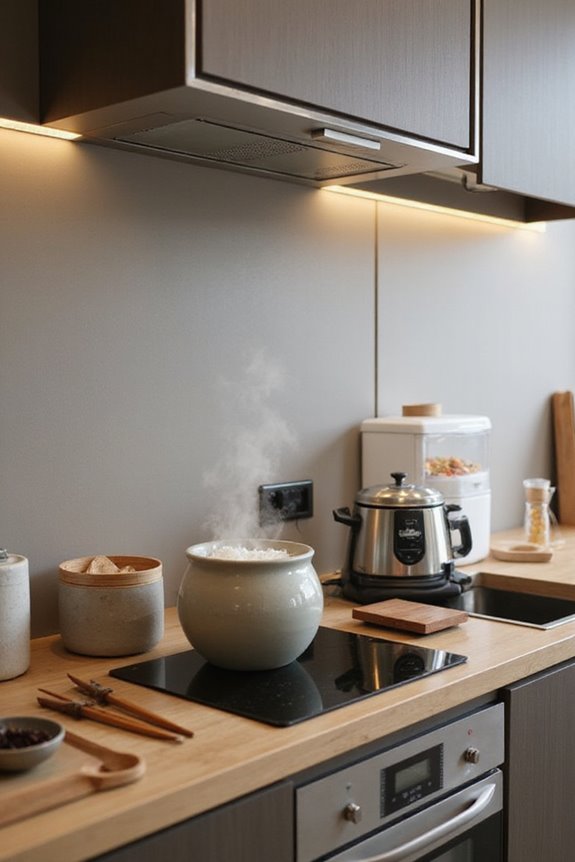
In any Korean kitchen, various food preparation appliances greatly enhance our cooking process, ensuring efficiency and consistency. One powerful appliance is the food processor, which allows us to chop, slice, and grate vegetables quickly. This is essential for making kimchi paste, saving us significant preparation time. Handheld blenders also provide several benefits; they’re perfect for creating smooth marinades or mashing mung beans for traditional pancakes. For soups, they efficiently blitz soybeans, ensuring we achieve the desired texture in our dishes. Automatic rice cookers are another indispensable tool, simplifying rice preparation. With one-touch operation, they keep rice warm until serving, making them essential for anyone cooking Korean meals regularly. By utilizing these appliances, we make our cooking experience more enjoyable and efficient. Additionally, a high-capacity rice cooker, like the Cuckoo High 6 Cup, can accommodate large family gatherings with ease.
Korean BBQ Specific Equipment
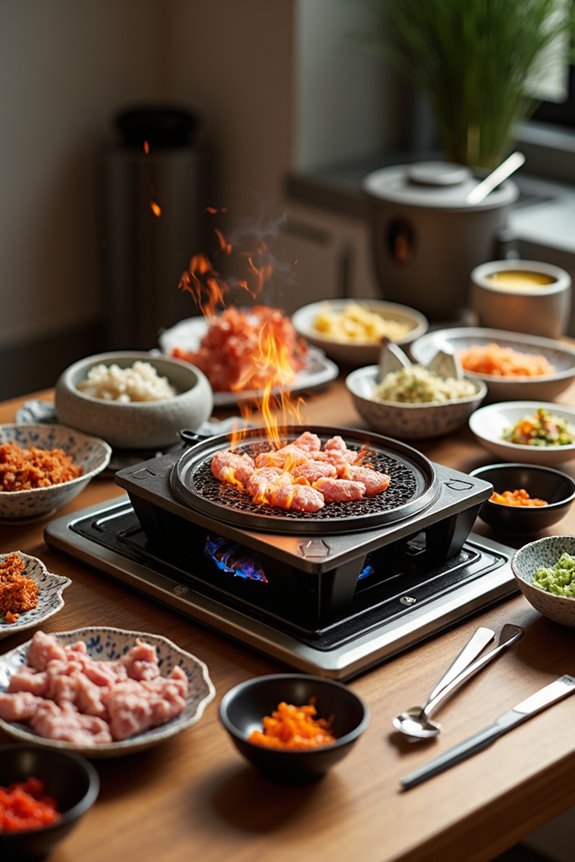
Korean BBQ is not just about the food; it also involves a variety of specialized equipment designed to enhance the grilling experience. Essential Korean BBQ equipment includes built-in grills, freestanding grills, and portable tabletop grills. Each type offers unique advantages for different cooking environments and preferences. Cooking surfaces play a vital role, as grill tops allow for direct flame exposure, while flat-top grills provide large, flat areas perfect for various meats and vegetables. Furthermore, grill accessories such as commercial-grade stainless steel tongs guarantee safe handling of both raw and cooked items. For a more personalized experience, grill surfaces can often be interchanged, enabling us to adapt our grilling technique based on the type of meat we’re cooking.
Specialty Refrigeration and Storage
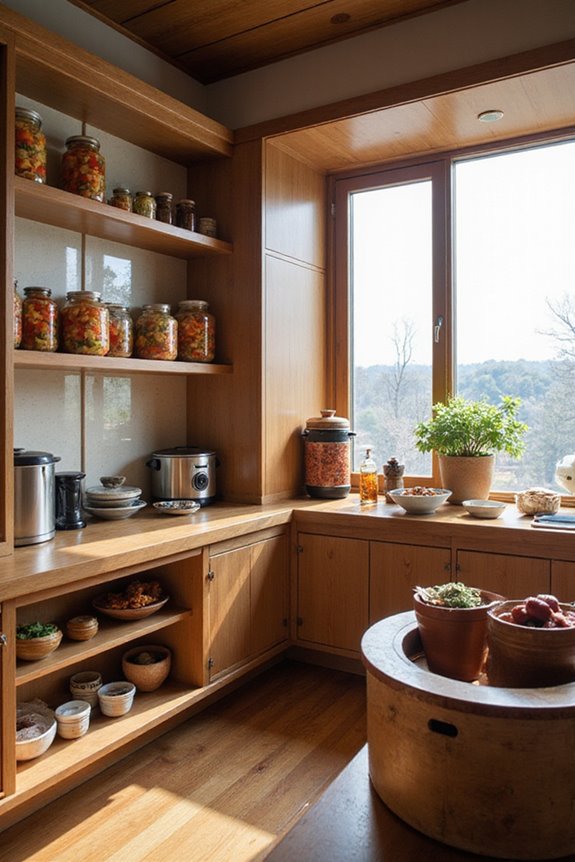
When operating a successful Korean kitchen, having specialized refrigeration and storage solutions is essential to guarantee ingredient quality and freshness. We need specialty refrigerators that provide precise temperature control, especially for items such as kimchi, which requires consistent low temperatures to preserve fermentation. Multi-compartment refrigerated units allow us to store marinated meats, seafood, and vegetables separately, preventing cross-contamination. Refrigerated prep counters positioned near cooking stations enhance workflow efficiency, while under-counter refrigerators comply with ADA regulations, maximizing space utilization. Additionally, beverage units designed for traditional drinks like soju and makgeolli help maintain ideal serving temperatures. By investing in reliable, energy-efficient refrigeration, we ensure our ingredients remain fresh and our kitchen operates smoothly and effectively.
Essential Ingredients and Condiments
Essential to the fabric of Korean cuisine, a well-stocked pantry filled with key ingredients and condiments allows us to create authentic flavors and textures in our dishes. Central to this are fermented sauces like ganjang, doenjang, and gochujang, which provide foundational tastes in soups, stews, and marinades. Gochugaru, the distinctive Korean chili powder, is vital for adding heat and is versatile enough for kimchi and sauces. Sesame oil and seeds offer aromatic finishes and nutty profiles, enhancing many recipes. Additionally, pantry staples such as rice flour, garlic, and fresh scallions contribute depth to our cooking. Together, these ingredients form the backbone of Korean culinary tradition, ensuring every meal is flavorful and satisfying.
Additional Useful Tools
In crafting authentic Korean dishes, having the right tools can greatly enhance our cooking experience and improve efficiency in the kitchen. Besides knives and pots, additional useful tools include fermentation containers and pickling jars. Fermentation containers are essential for managing the fermentation process of dishes like kimchi, guaranteeing proper temperature and airflow. Airtight seal features in these containers prevent oxidation and spoilage, ensuring the longevity of flavors. Pickling jars, often glass or ceramic, provide an ideal environment for storing pickled vegetables, preserving flavors while preventing spoilage. Incorporating sharp scissors and a mandoline slicer allows for precise cutting, which is important when prepping ingredients. Meanwhile, stainless steel mixing bowls guarantee accuracy in mixing and marinating. Altogether, these tools streamline our culinary efforts, contributing to the creation of authentic Korean recipes and experiences.
Frequently Asked Questions
What Type of Oil Is Best for Korean Cooking?
When it comes to Korean cooking, we love sesame oil for its nutty flavor and perilla oil for its unique richness. Both are essential for seasoning and finishing dishes, elevating our culinary creations beautifully.
How Can I Maintain My Cast Iron Pot?
Maintaining our cast iron pot is like nurturing a precious treasure! We can enhance its longevity through diligent cast iron care—employing proper seasoning techniques and avoiding moisture, ensuring it remains our kitchen’s trusted companion for years.
Are There Alternative Tools for Kimchi Preparation?
When prepping kimchi, we can use vegetable shredders for efficient chopping and fermentation jars to properly store our creations. These alternatives make the process smoother without sacrificing flavor or quality in our delicious dishes!
What Is the Purpose of a Kimchi Refrigerator?
We believe the primary purpose of a kimchi refrigerator is to optimize kimchi preservation techniques, maintaining an ideal fermentation temperature. This specialized storage guarantees flavor retention and freshness, enhancing our enjoyment of this cherished dish.
How Do I Choose the Right Size Skillet for My Kitchen?
When we dance through the culinary landscape of skillet sizes, we find that our cooking styles dictate our choices. Let’s embrace medium skillets for versatility while smaller ones perfect our delicate creations. The rhythm of our kitchen awaits!

